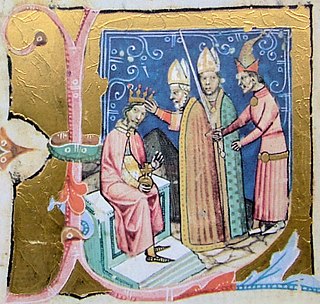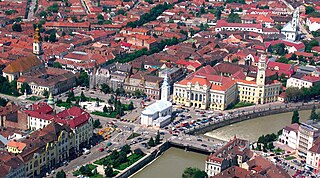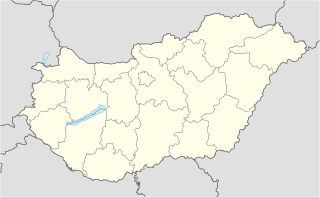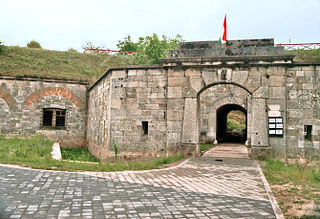
Artúr Görgei de Görgő et Toporc was a Hungarian military leader renowned for being one of the greatest generals of the Hungarian Revolutionary Army.

Count Lajos Batthyány de Németújvár was the first Prime Minister of Hungary. He was born in Pozsony on 10 February 1807, and was executed by firing squad in Pest on 6 October 1849, the same day as the 13 Martyrs of Arad.

József Nagysándor was a honvéd general in the Hungarian Army. He was executed for his part in the Hungarian Revolution of 1848, and is considered one of the 13 Martyrs of Arad.

György Lahner was a honvéd general in the Hungarian Army. He was executed for his part in the Hungarian Revolution of 1848, and is considered one of the 13 Martyrs of Arad.

Ignác Török was a honvéd general in the Hungarian Army. He was executed for his part in the Hungarian Revolution of 1848, and is considered one of the 13 Martyrs of Arad.

The Battle of Schwechat was a battle in the Hungarian Revolution of 1848, fought on 30 October 1848 between the revolutionary Hungarian Army against the army of the Austrian Empire, in Schwechat, near Vienna. This was the last battle of 1848 in the Transdanubian campaign. The Hungarian Army was under the command of János Móga and the Austrian Army was under the command of Alfred I, Prince of Windisch-Grätz.
The 1848–1849 massacres in Transylvania were committed in the Hungarian Revolution of 1848. According to Egyed Ákos, 14,000 to 15,000 civilians were massacred in Transylvania in this period. The victims were composed of 7,500–8,500 Hungarians, 4,400–6,000 Romanians, and about 500 Saxons, Armenians, Jews, and members of other groups.

General Staff of the Armed Forces of Hungary is a joint body organised within the Ministry of Defence.

Dénes Pázmándy de Szomor et Somodor was a Hungarian landowner and politician, who served as Speaker of the House of Representatives between 1848 and 1849.
Dénes Lukács may refer to:
The Siege of Temesvár was a siege during the Hungarian Revolution of 1848 between the Austrian Empire and Hungarian Revolutionary Army. The Hungarians unsuccessfully tried to capture the Timișoara Fortress.

The Royal Hungarian Honvéd or Royal Hungarian Landwehr, commonly known as the Honvéd or in Hungarian, Honvédség, was one of the four armed forces of Austria-Hungary from 1867 to 1918. The others were its counterpart the Austrian Landwehr, the Common Army and the Imperial and Royal Navy. The word "honvéd" means and enlisted private without a rank, literally "Defender of the Homeland". "Honvédség" is degree of the noun and refers to the community, institution of these soldiers.

Lucas, also Luke, was a Hungarian prelate in the 12th century. He was Bishop of Eger between 1156 and 1158, and Archbishop of Esztergom from 1158 till his death in 1181.

András Gáspár was a Hungarian general who fought in the Hungarian War of Independence of 1848–1849.

The Battle of Tápióbicske was a battle in the Spring Campaign of the Hungarian War of Independence (1848–1849), fought on 4 April 1849 between the Austrian Empire and the Hungarian Revolutionary Army. The Habsburg forces consisted of the I Corps of the Imperial Army led by Lieutenant Field Marshal Josip Jelačić. The Hungarians deployed I and III Corps led by General György Klapka and General János Damjanich respectively. The Hungarians were victorious, and thanks to this, the main Hungarian armies advanced towards the Hungarian capitals, forcing the Austrian high commander, Field Marshal Alfred I, Prince of Windisch-Grätz fight a decisive battle at Isaszeg, which would decide the fate of Central and Western Hungary until the intervention of the Russian forces on the Habsburg side in June 1849.

The Battle of Nagysalló, fought on 19 April 1849, was one of the battles between the Habsburg Empire and the Hungarian Revolutionary Army during the Spring Campaign in the Hungarian War of Independence from 1848–1849, fought between the Habsburg Empire and the Hungarian Revolutionary Army. Until 1918 Nagysalló was part of the Kingdom of Hungary; nowadays it is a village in Slovakia, its Slovakian name being Tekovské Lužany. This was the second battle in the second phase of the campaign, whose aim was to break the imperial siege of the fortress of Komárom and at the same time encircle the Habsburg imperial forces headquartered in the Hungarian capitals of Buda and Pest. The Hungarians routed the imperial corps led by Lieutenant General Ludwig von Wohlgemuth, which had come from the Habsburg Hereditary Lands, to help the imperial army sent to suppress the Hungarian Revolution of 1848 and independence.

The First battle of Komárom was one of the most important battles of the Hungarian War of Independence, fought on 26 April 1849, between the Hungarian and the Austrian Imperial main armies, which some consider ended as a Hungarian victory, while others say that actually it was undecided. This battle was part of the Hungarian Spring Campaign. After the revolutionary army attacked and broke the Austrian siege of the fortress, the Imperials, having received reinforcements which made them numerically very superior to their enemies, successfully counterattacked, but after stabilising their situation, they retreated towards Győr,leaving the trenches and much of their siege artillery in Hungarian hands. By this battle the Hungarian revolutionary army relieved the fortress of Komárom from a very long imperial siege, and forced the enemy to retreat to the westernmost margin of the Kingdom of Hungary. After this battle, following a long debate among the Hungarian military and political leaders about whether to continue their advance towards Vienna, the Habsburg capital, or towards the Hungarian capital, Buda, whose fortress was still held by the Austrians, the second option was chosen.

The Second Battle of Komárom, sometimes known as the Battle of Ács, took place at 2 July 1849, between the Hungarian army led by General Artúr Görgei and the imperial army of Austria led by Field Marshal Julius von Haynau, which had also an almost 12 000 strong Russian contingent led by Lieutenant General Fyodor Sergeyevich Panyutyin. The imperial army outnumbered the Hungarian troops by 2 to 1, was superior also regarding the multitude of infantry and light as well as heavy (cuirassiers) cavalry unit types, and the quality of the weapons. Except the problems of military kind, problems of other kind also influenced negatively the Hungarian army. Short before the battle, the conflict between the Hungarian commander, Görgei, and the political leadership of Hungary, Lajos Kossuth and the Szemere-Government, escalated abruptly. The government lead by Kossuth, decided to retreat the Hungarian troops from the perfectly defendable Komárom to Southern Hungary, leaving half of the country in the hands of the enemy, without consulting the war minister Görgei, who was the only person with the right to take a military decision. Görgei considered this illegal decision as very wrong, but he accepted to execute it, in order to avoid the confrontation with the political leadership in such a critical military situation, fixing the date of the depart towards southern Hungary to 3 July. But despite of this, on 31 June Kossuth laid off Görgei from the high commandement of the Hungarian army, because he had read two of the latters letters in the wrong order. All these caused uncertainity and conflicts among the Hungarian officers and also soldiers before this very important enemy attack. Kossuth even sent Lieutenant General Lázár Mészáros to Komárom, to take the leadership from Görgei, and send him to Pest. But when Mészáros approached on 2 July, on a steam boat, to Komárom, he heard the gunshots of the battle, and returned to Pest.
The Austrian Supreme Commander Field Marshal Julius Jacob von Haynau's plan was to force the Hungarian troops to retreat in the fortress of Komárom, to lay, with a part of his army, a siege against it from the south, opening in this way the road towards Buda and Pest. After accomplishing this goal the bulk of Haynau's troops had to advance towards East, and occupy the Hungarian capitals, before his allies, the Russian main troops led by Ivan Paskevich, arrived there.
The battle started on the early morning of 2 July with the attack of the I corps led by General Franz Schlik of the imperial troops from the direction of Ács, chasing quickly away the Hungarians from the Ács forrest, then pushing them into the fortifications lying South from Komárom, and even capturing the Monostor-trenches, thus entering in the fortifications, menacing to occupy the whole southern fortification and trench system of the fortress, putting in danger the Hungarian troops from there, to be completely encircled.
The main aim of the third Battle of Komárom was to break through Haynau's blockade. Klapka took over the command of Görgey's army because of Görgey's injury. The Hungarian Government gave an order to the army to advance towards Maros. Görgey didn't follow the command because Haynau's army blocked the way south. The government gave a new order and on 11 July the Hungarian army started to attack the Austrians. New Hungarian troops arrived under the command of Ármin Görgey, and from Bátorkeszi under József Nagysándor.

Alajos Degré was Hungarian lawyer, legal historian, author and one of the key figures of the Hungarian Revolution of 1848.























